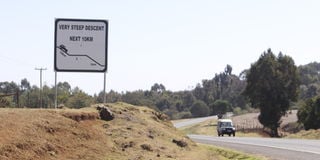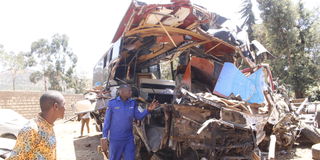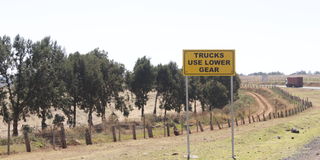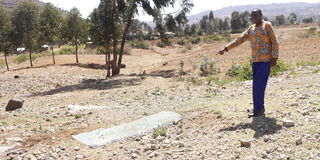Premium
Why Subuiga on Nanyuki-Meru road is a blackspot

A road sign along the 10 kilometre Subuiga stretch along the Nanyuki-Meru road.
Drivers on the Nanyuki-Meru road heading to the Subuiga blackspot see a beautiful, rolling scenic landscape created by canola, pine and wheat farms, with many roadside traffic signs warning of danger ahead.
The 10-kilometre winding steep descent that divides into the Nanyuki-Meru and Nanyuki-Isiolo roads at the Subuiga junction has claimed many lives and maimed others since the road was built in the 1970s.
This stretch is not only enthralling but is also a vantage point for viewing the snowcapped Batian, the highest peak of Mt Kenya.
The picturesque yet dangerous descent starts near the Kisima farm gate, where a big sign put up by the Kenya National Highways Authority (Kenha) bears the words ‘Very steep descent, next 10 km’ has been.
After every one kilometre, there are warning signs advising drivers to use low gears, alerting them of danger ahead, a blackspot and dangerous curves, and urging them to observe lane discipline among others.
The road signs also remind truck drivers to ‘use lower gear’ about five kilometres before the Subuiga-Isiolo turn-off.
As you close in on the deadly spot, the traffic signs scream: ‘Danger’, ‘Accident blackspot’, ‘Steep descent’, ‘Slow’, ‘Dangerous section’, backed up by a continuous yellow line.

Wreckage of vehicles involved in accidents at Subuiga Police Station.
A tattered red flag, installed by pastors who pray over highway blackspots to exorcise the demons of accidents, is the last in the lineup of warning signs.
“As you can see, the flag is now torn. This is a reminder that we need to hold prayers immediately. We pray over this spot every year because we believe God can avert accidents. This road has claimed too many lives,” says Pastor Anderson Muthiora, a resident of Subuiga.
Pastors have organised prayers next Sunday to hoist a new red flag.
The most recent and worst accident since 2013 was a week ago, with 12 people dying when a bus rammed a matatu and a trailer after its driver lost control.
In December 2013, 10 people died on the spot after a trailer rolled and rammed into five vehicles.
In August 2017, four people died when a trailer overturned and fell on a private car, while in February 2018, four people died after a trailer rammed a house as a family slept.
The wreckage lying at the Subuiga police station and on the land directly opposite the steep stretch, illustrates the danger of the blackspot.

A road sign along the 10 kilometre Subuiga stretch along the Nanyuki-Meru road.
Buuri West Base Commander John Bosco Mulei says the spot has claimed more than 22 lives in the last nine months.
“The pattern we have noted here is that most of the accidents are caused by trucks, trailers and buses with new drivers,” Mr Mulei observes.
“If a truck driver fails to engage a low gear at the beginning of the descent, they are most likely to lose control of the vehicle. It is very dangerous when drivers engage a free gear on this stretch.”
Mr Mulei says residents who were living on the land directly opposite to the steep stretch had to relocate for their safety.
“A curio shop that used to be here was rammed about seven times. A residential house was recently [hit], forcing the family to move. No development can be done here because trailers that have lost control are directed into this land,” he says.
Four shattered windscreens, broken beer bottles and an abandoned truck body are some of the stark reminders of the many accidents that have happened here.
Mr Mulei says that though Kenha has put up more traffic signs on the stretch, accidents caused by careless driving persist.
“I also advised Kenha to put up rumble strips at a bus stop near the junction after we noted it was very dangerous for parked vehicles. A trailer recently rammed into a vehicle that was parked there,” he says.

A road sign along the 10 kilometre Subuiga stretch along the Nanyuki-Meru road.
Mr Kiruki Mwithimbu, a mechanical engineer and writer, explains that the main cause of accidents in Subuiga is brake failure in heavy vehicles.
“Once in motion, trucks and buses are stopped by brake linings that are built into the brake drums that are part of the wheel assembly,” Mr Mwithimbu explains on Facebook.
“When brakes are applied, the whole ensemble gets hot as the rolling energy is dissipated into friction to slow and eventually stop the vehicle.
“When the resulting heat becomes too much, the lining and drum contact lose grip. This is the phenomenon that causes trucks and bus accidents on the steep stretches of Sulbuigaa and the infamous Salgaa of Nakuru.”
He adds: “A road designed for trucks should not have a 15-kilometre stretch of continuous brake application as the inevitable overheating will create the brake-fade that ultimately results in accidents. Every qualified civil engineer should know this...”
Mr Mwithimbu says a safer alternative route is needed for heavy trucks that ply the Nanyuki-Isiolo-Marsabit route.
“The salvation of Sulbuigaa will be realised when the road is reverted to the old Kangangi road that joined Timau directly with Ntumburi through Ngare Ndare forest and the famous Lewa conservancy,” he writes.

Mr Anderson Muthiora, a pastor at Subuiga in Meru shows remains of some of the houses that have been relocated due to ramming by trailers that lose control at the Subuiga black spot.
“All other promises by government functionaries and occasional prayers to exorcise the demons of Sulbuigaa are bouts of hot-air as recently decreed by the Supreme court of Kenya!”
Buuri MP Mugambi Rindikiri blamed most of the accidents on speeding and dangerous overtaking at the stretch.
“I am calling on all drivers to exercise caution on that road and adhere to the traffic signs placed along the blackspot,” he said.
Pastor Muthiora says he has witnessed about seven accidents at the spot this year and urged authorities to address the problem.
“We have noted that most of the accidents involve heavy vehicles with drivers who are new to the route. Since this pattern is established, it is advisable that an alternative route be sought for heavy trucks,” he says.
The 50-kilometre Timau-Ngare Ndare-Lewa Conservancy road, which is being tarmacked, has been touted as a safer alternative to the deadly Subuiga stretch because it is not hilly.





